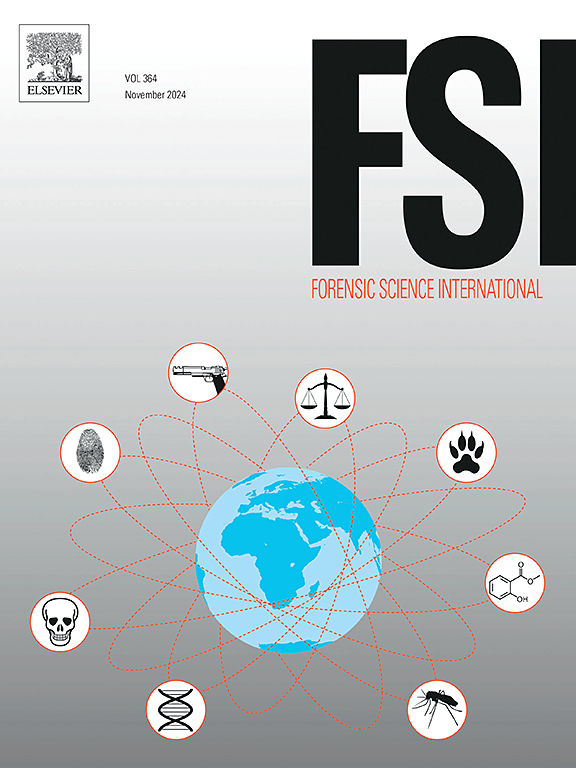On the influence of various factors on the recovery efficiency and individual identification capability of exfoliated cells on chopsticks
IF 2.2
3区 医学
Q1 MEDICINE, LEGAL
引用次数: 0
Abstract
In practical investigations, many biological samples containing exfoliated cells turn up at crime scenes, e.g., cigarette butts, glasses of water, clothing, chopsticks, etc. Improving the detection rate of exfoliated cells at crime scenes to obtain effective information is the focus of investigation work, but studies on chopsticks are relatively limited. This study investigated the influence of capture methods, chopstick textures, detergent treatment, exposure time and type of food on the recovery efficiency and individual identification capability of DNA from exfoliated cells of chopsticks. A cotton swab showed better DNA recovery efficiency than a flocked nylon swab and a exfoliated cells collector for four chopstick textures. The variation in DNA recovery efficiency shows a discrepancy between the different chopstick textures leading to bamboo > wood > plastic > stainless steel. After detergent treatment, relatively complete profiles (95.39–97.42 %) of the exfoliated cells DNA on bamboo and wooden chopsticks were still obtained. The recovery efficiency and persistence of DNA on bamboo and wooden chopsticks are higher and less affected by external factors. The effect of food types on the exfoliated cells on chopsticks showed that the quality of DNA profiles obtained after eating noodles and rice compared to hot pot can be used for downstream individual identification. This work has shown that the different porosity of chopstick textures leads to a different ability of chopsticks to absorb DNA. The exfoliated cells on bamboo and wooden chopsticks after treatment with detergents, a 30-day exposure or the consumption of noodles and rice are also a valuable tool to identify the perpetrator and/or the victim. These results could be useful in police investigations and in court to assess the chances of successful DNA genotyping and to facilitate decisions on the usability of DNA recovered from crime scenes.
各种因素对筷子上脱落细胞回收率和个体识别能力的影响
在实际调查中,许多含有脱落细胞的生物样本出现在犯罪现场,如烟头、水杯、衣服、筷子等。提高犯罪现场脱落细胞的检出率,获取有效信息是侦查工作的重点,但对筷子的研究相对有限。研究了捕获方法、筷子质地、洗涤剂处理、暴露时间和食物种类对筷子脱落细胞DNA的回收效率和个体识别能力的影响。对于四种筷子质地的DNA,棉签比尼龙棉签和去角质细胞收集器显示出更好的DNA恢复效率。DNA恢复效率的变化表明,不同质地的筷子之间存在差异,导致竹>; 木材>; 塑料>; 不锈钢。洗涤剂处理后,竹筷和木筷上脱落细胞的DNA图谱仍较为完整(95.39 ~ 97.42 %)。竹筷和木筷上DNA的恢复效率和持久性较高,受外界因素影响较小。食物种类对筷子上脱落细胞的影响表明,与吃火锅相比,吃面条和米饭后获得的DNA图谱质量可用于下游个体鉴定。这项工作表明,筷子纹理的不同孔隙率导致筷子吸收DNA的能力不同。竹筷和木筷上经过洗涤剂处理、接触30天或食用面条和大米后脱落的细胞也是识别肇事者和/或受害者的宝贵工具。这些结果可能对警方调查和法庭评估成功进行DNA基因分型的机会有用,并有助于对从犯罪现场恢复的DNA的可用性作出决定。
本文章由计算机程序翻译,如有差异,请以英文原文为准。
求助全文
约1分钟内获得全文
求助全文
来源期刊

Forensic science international
医学-医学:法
CiteScore
5.00
自引率
9.10%
发文量
285
审稿时长
49 days
期刊介绍:
Forensic Science International is the flagship journal in the prestigious Forensic Science International family, publishing the most innovative, cutting-edge, and influential contributions across the forensic sciences. Fields include: forensic pathology and histochemistry, chemistry, biochemistry and toxicology, biology, serology, odontology, psychiatry, anthropology, digital forensics, the physical sciences, firearms, and document examination, as well as investigations of value to public health in its broadest sense, and the important marginal area where science and medicine interact with the law.
The journal publishes:
Case Reports
Commentaries
Letters to the Editor
Original Research Papers (Regular Papers)
Rapid Communications
Review Articles
Technical Notes.
 求助内容:
求助内容: 应助结果提醒方式:
应助结果提醒方式:


